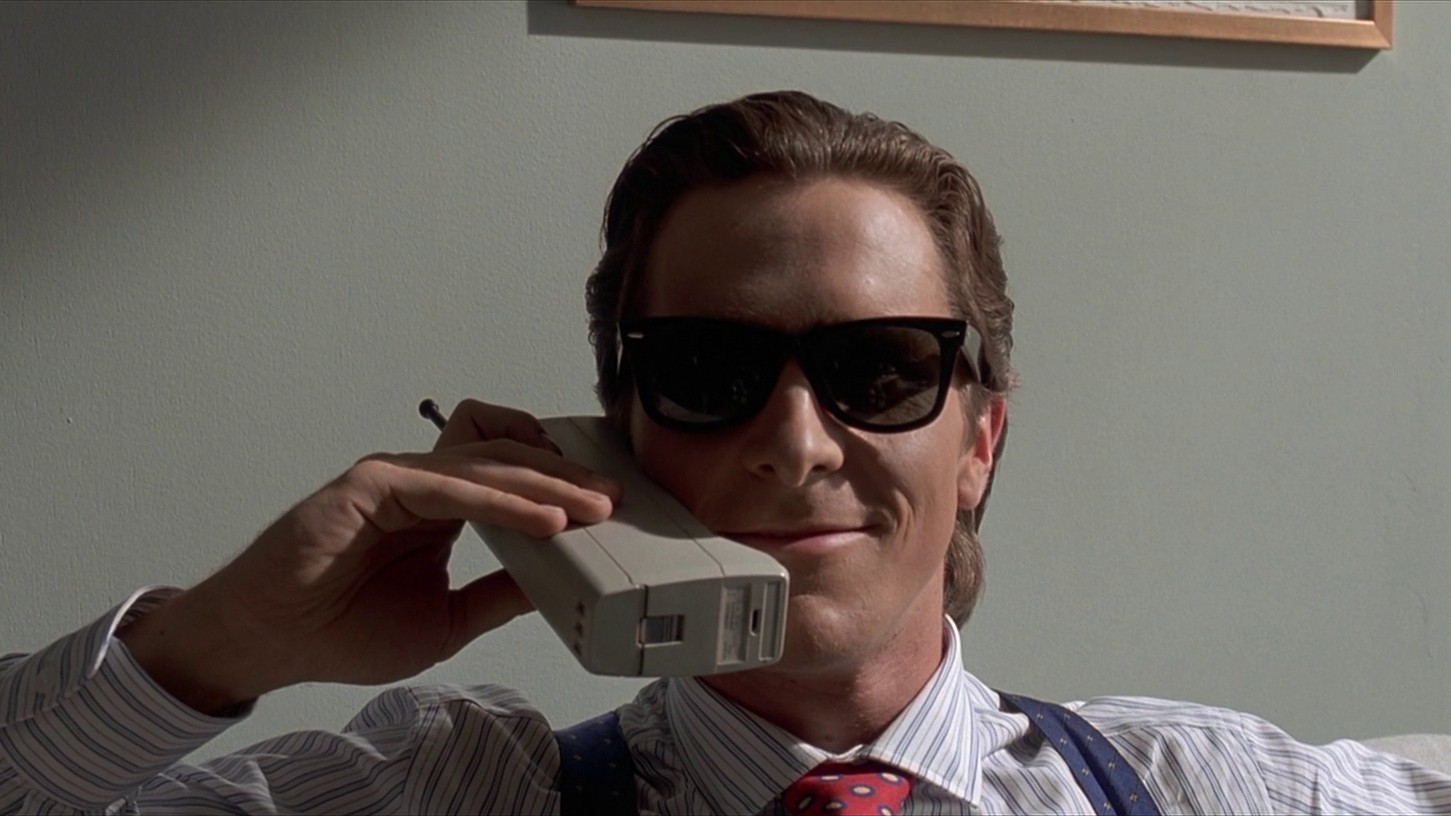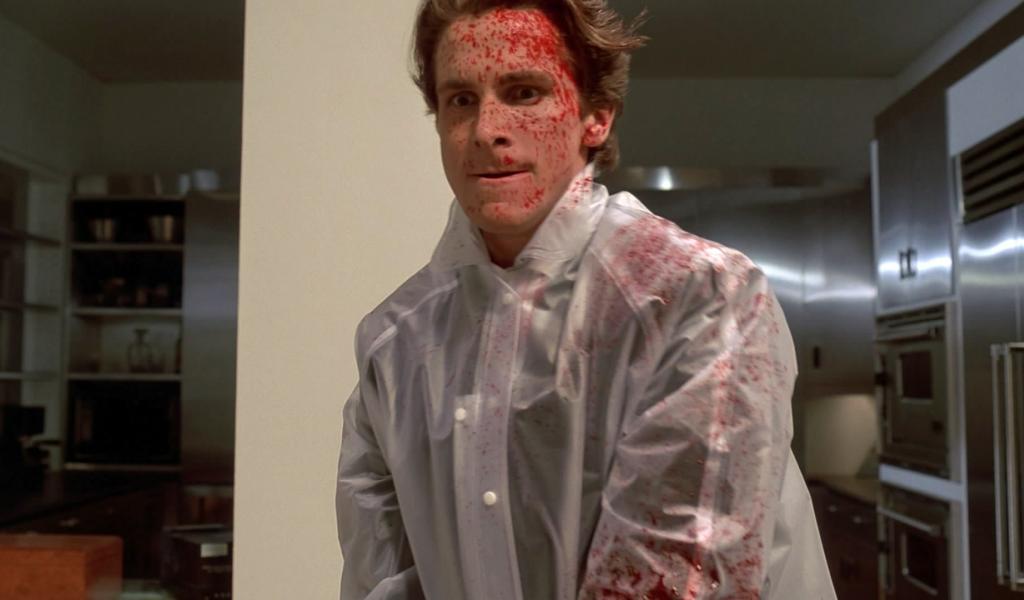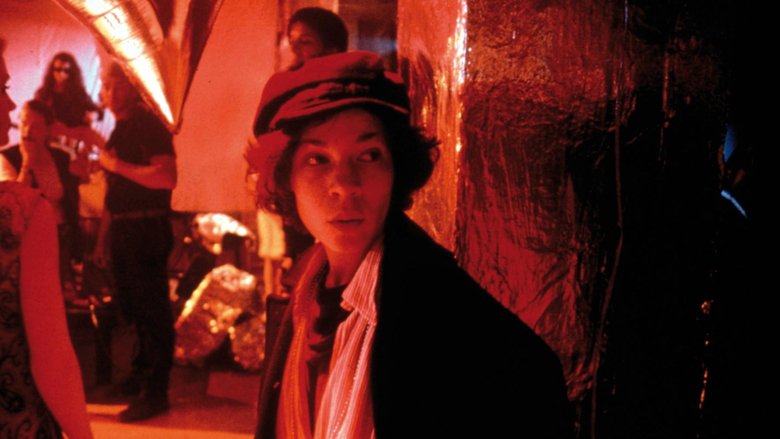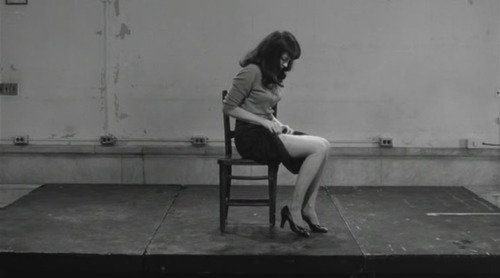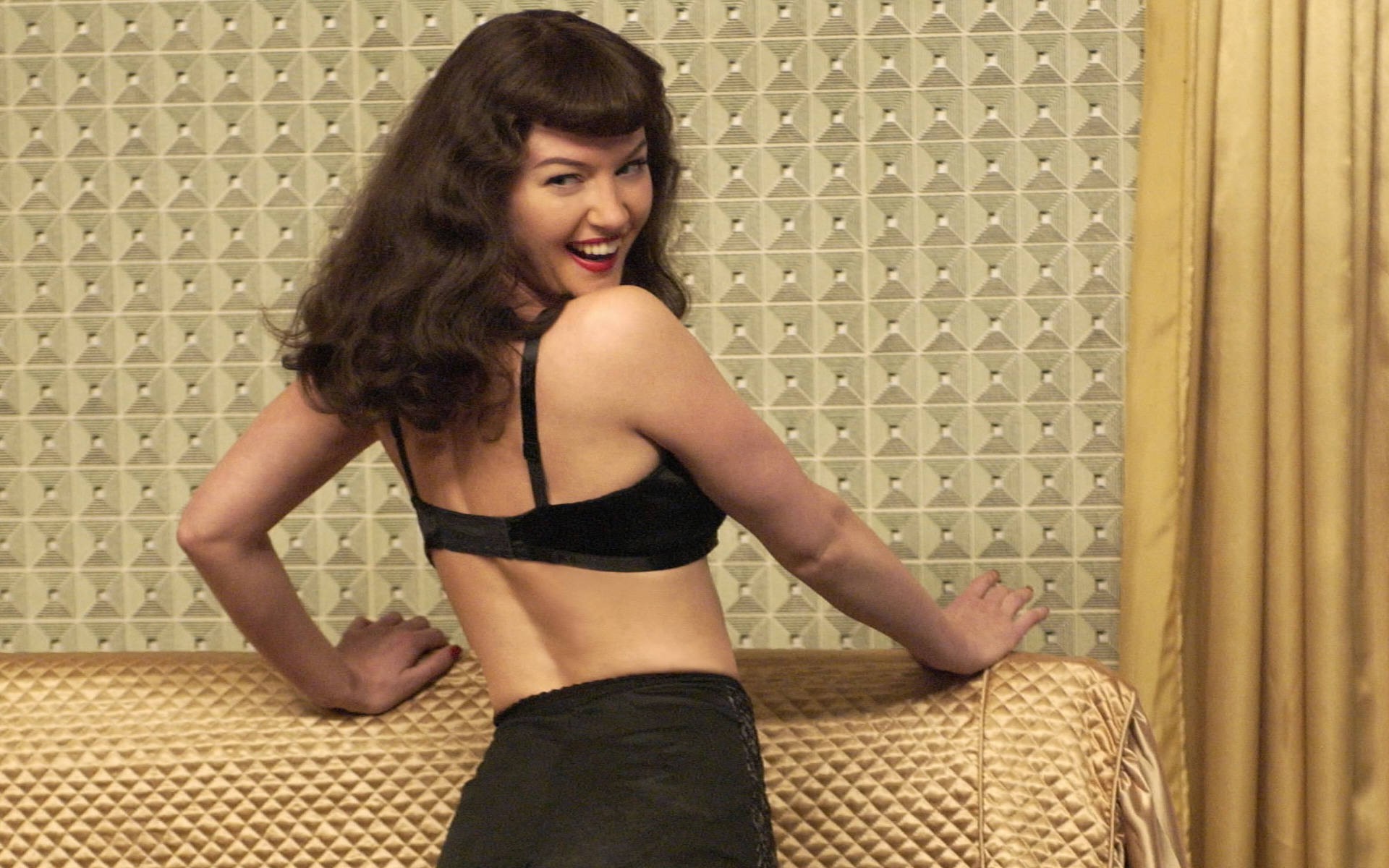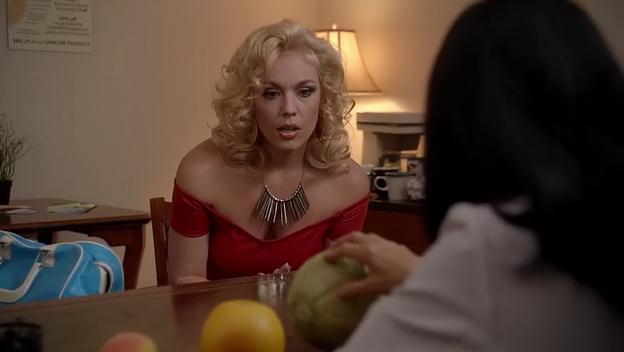This guest post written by Caroline Madden is an edited version of an article that originally appeared at Screenqueens. It is cross-posted with permission.
A 2006 YouTube video created a parody trailer envisioning American Psycho (2000) as romantic comedy. While the stark juxtapositions between the classic boy-meets-girl formula and a horrifying portrait of a serial murder are amusing, the sentiments between them are not so far-fetched. Although primarily a horror film, American Psycho has a satiric backbone that appropriates codes from the romantic comedy genre to expose the absurdities of our gender ideals. Director and co-writer Mary Harron’s lens skewers the qualities we find appealing in romantic comedies as terrifying.
Patrick Bateman (Christian Bale) is a concoction of the romantic comedy and drama archetype of “the bad boy.” He’s Julian Kaye (Richard Gere) in American Gigolo (1980) meets Fifty Shades of Grey’s (2014) Christian (Jamie Dornan). Near identical scenes portray their fetishistic consumption of high-class material goods. They inhabit modern-architecture utopias enveloped in glass windows and filled with famous artworks. They have closets full of immaculate designer suits that they softly glide their hands over as if they were ancient relics. These characters engage in sacred manscaping rituals and rigorous exercises to construct Herculean physiques. No strand of hair out of place, no wrinkles in sight. The hetero and bi female audience (and gay and bi male audience) ogles these perfect creatures who are made all the more enticing by their inscrutable personalities. Women are consistently told to fawn over this image of the handsome, cynical bachelor who can’t be tied down.
Christian Bale particularly modeled his performance off of the (former) rom-com icon Tom Cruise. Watching American Psycho, it becomes clear how well Bale infuses Cruise’s frenetic energy and high-watt smiles. The “Show me the money!”-esque freakout in the dry cleaners scene best exemplifies his influences. But beneath that charismatic veneer, Mary Harron said Bale observed an “intense friendliness with nothing behind the eyes,” which he extrapolated to account for Patrick Bateman’s alien disengagement from humanity. Furthermore, the iconic romantic Cruise character Jerry Maguire draws similar threads to Patrick. He is the “bad boy,” trading the stoicism of Christian (50 Shades of Grey) and Julian (American Gigolo) for a jackrabbit vivacity; he is the detached bachelor drowning in shallow ideals, easy flings, and over-commitment to his work.
The creator of the YouTube video, filmmaker Dan Riesser, stages Patrick as the aforementioned cynical bachelor figure in the American Psycho rom-com. We view a rapid-cut montage of all the women in his life: lovers, flings, and hook-ups. The video positions Chloë Sevigny’s character, the dowdy but doting secretary Jean, as the potential true love to change his Lothario ways. A close analysis of Patrick’s scenes with various women throughout the film reveals that these romantic comedy elements are no trick of the YouTube editor but rather clearly infused in director Harron’s construction.
Jean is the sweet, shy girl due for a makeover, a trope seen in countless romantic comedies, such as She’s All That (1999). Jean’s mousy image opposes Patrick’s cool, aloof, bad boy; he is the one that could encourage her to break out of her shell — in other words, the plot of Fifty Shades of Grey. Patrick encourages her to dress prettier, to wear skirts and heels instead of boxy pantsuits; Jean is shown dutifully following his request in the next scene. She shows clear interest in Patrick as she pitifully asks if he has something romantic planned for his dinner reservations.
Patrick eventually asks Jean out on a date and they meet at first at his apartment. We know the real undertones to Patrick’s intentions as he slyly fetches duct tape and a knife. There’s a head in the freezer next to the ice cream he offers. Patrick tries to make a joke about Ted Bundy but Jean doesn’t know who he is. Bale’s hilarious disappointed reaction is a reversion of Tom’s (Joseph Gordon Levitt) elation to find a girl who loves The Smiths in 500 Days of Summer (2009). If only Jean could love Ted Bundy as much as he did, maybe she could be the one. Patrick parrots the sweet-talk of romance films as he makes Jean feel special by asking questions about herself and telling her, “I just want to have a meaningful relationship with someone special.” Jean clearly is infatuated by this, unbeknownst that Patrick is holding a nail gun behind her head. He spares her after a message from his fiancée Evelyn (Reese Witherspoon) plays on the machine. He tells Jean that she should leave for he doesn’t know if he could control himself. Patrick is referring to his homicidal tendencies but Jean takes this as a sexual suggestion. She laments her penchant for unavailable men, she would not want to sleep with an engaged man. This exchange is a morbid doppelgänger of the double-entendres and miscommunications often found in the romantic comedy.
Romantic comedies often paint the “other woman,” who the male lead foolishly wastes his time and devotion on, as shrewd and vapid. The playboy bachelor may share some of those vapid qualities, but the female romantic lead can see the heart of gold waiting to be unearthed — rather, what Jean hopes to find in her quest to charm her indecipherable boss. Evelyn perfectly embodies the cliché of heartless fiancée in her ice-blue suits and obnoxious disregard for Patrick’s zen Walkman moments. She just doesn’t let him be himself! Patrick also wastes his time with a ridiculous fling, Courtney (Samantha Mathis), who drowns herself in pills.
Harron undercuts this satirical imagery of women with Patrick’s very real violence towards them. There is no Cinderella or Pygmalion story awaiting the sex workers at his home, no magic shopping trip to transform them into high society princesses. The serial killer is certainly not Richard Gere from Pretty Woman (1990). After a zealous threesome, Harron shows Patrick wielding a wire hanger and purveying various instruments of torture. Patrick Bateman may fit the playboy image, but he is not the handsome prince of our dreams.
Harron and co-writer Guinevere Turner employ a satiric focus on Patrick’s shallow, jaded, and interchangeable yuppie friends to critique self-aggrandizing collective masculinity. He and his three friends swap fetishistic knowledge of luxury brands and designer labels over cocktails like a gender-swapped version of Sex and the City (1999). Their subsequent discussion of a woman’s looks versus personalities is purported from classic rom-com ethos. They laugh and high-five each other after exclaiming in unison, “There are no girls with good personalities!” Craig McDermott (Josh Lucas) follows, “Listen, the only girls with good personalities who are smart or maybe funny or halfway intelligent or even talented — though God knows what the fuck that means — are ugly chicks because they have to make up for how fucking unattractive they are.” Although Harron mocks the male characters through this sardonic exchange, we cannot ignore that this comes from very real ideals avowed in the typical romantic comedy. It is eerily similar to an exchange from When Harry Met Sally (1989):
Jess: Yeah but you also said she has a good personality.
Harry: She has a good personality.
Harry: What?
Jess: When someone is not that attractive, they’re always described as having a good personality.
Harry: Look, if you would ask me, “What does she look like?” and I said, “She has a good personality.” That means she’s not attractive. But just because I happened to mention that she has a good personality, she could be either. She could be attractive with a good personality, or not attractive with a good personality.
Jess: So which one is she?
Harry: Attractive.
Jess: But not beautiful, right?
The group continues their disparaging remarks, David Van Patten (Bill Sage) says, “A good personality consists of a chick with a little, hard body who will satisfy all sexual demands without being too slutty about things and who will essentially keep her dumb fucking mouth shut.” We turn to the rom-com The Ugly Truth:
“You want a relationship; here’s how you get one: it’s called a Stairmaster. Get on it and get skinny and get some trashy lingerie while you’re at it because at the end of the day, all we’re interested in is looks. And no one falls in love with your personality at first sight. We fall in love with your tits and your ass. And we stick around because of what you’re willing to do with them. So you want to win a man over? You don’t need ten steps. You need one. And it’s called a blowjob.”
While the cynical bachelor of The Ugly Truth gets reformed, the toxic messages remain. This disturbing vision of gender relations categorizes women’s merit based purely on appearances and both shames and suppresses their independent sexual desire. Romantic comedies play on these ideals for laughs but they are inherently rooted in our societal subconscious. The men of American Psycho may be parodies, but we experience their dialogue and message on a tangible level throughout various films.
Ultimately, Mary Harron approaches the romantic comedy elements of American Psycho as Patrick Bateman approaches music. He waxes poetic about the underlying message of Huey Lewis’ “Hip to be Square” and Whitney Houston’s “The Greatest Love of All.” Seemingly saccharine self-love anthems or bopping pop grooves become a “universal message [that] crosses all boundaries and instills one with the hope that it’s not too late to better ourselves, to act kinder” and “not just about the pleasures of conformity and the importance of trends, it’s also a personal statement about the band itself.” On its surface, the romantic comedy is a confectionary salve for the mind. We crave the simple pleasures of these unrealistic fairy tales coupled with hearty laughs. Underneath, the genre often blankets the divisive and often sexist ideals of the “men are from Mars, women are from Venus” adage. Often the “bad boy” cliché of real life is an abusive and violent person, perhaps not on the level of Patrick Bateman but certainly sharing similar fearful and misogynist qualities. And a makeover should not be the defining quality that entices a man to fall for a woman. I wonder what Patrick Bateman would have to say about “Walking on Sunshine,” which he bops to in the hall. Perhaps the narrator is similar to the female figures in romantic comedies, waiting for her cynical bachelor by the mailbox and to be with her for more than a weekend. Romantic comedies teach us to look for “the love that’s really real” in all the wrong places.
See also at Bitch Flicks:
Mary Harron’s American Psycho: Rogue Feminism
Caroline Madden has an MA Cinema Studies from Savannah College of Art and Design. Other writing can be found on Screenqueens, Pop Matters, and her blog Cinematic Visions. Film and Bruce Springsteen are two of her most favorite things.
